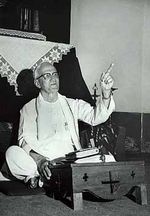American Methodist Missionary to India, Global Evangelist, and Author

Born in Clarksville, Maryland, E. Stanley Jones was converted at age 17, studied law, and graduated from Asbury College in 1906. In 1907, under the Board of Mission of the Methodist Episcopal Church, he went to Lucknow, India, where he had a fruitful pastorate. Ordained both a deacon and an elder in 1908, he worked as district missionary superintendent and revival preacher.

Responding to a call to serve India’s intelligentsia, he delivered carefully prepared addresses (later published as widely influential books), followed by grueling question periods, in public halls throughout India. His early narrow and individualistic approach became more liberal and social. His roundtable conferences predated the interfaith dialogue emphasis of the World Council of Churches.
He attended meetings of the International Missionary Council at Jerusalem (1928) and at Madras (1938). He declined episcopal election (1928). He founded a Christian ashram at Sat Tal in the Himalayas (1930) and later an international ashram movement. He was a friend of Mahatma Gandhi and other national leaders of all religions. His interest in mental health led to the founding of Nur Manzil Psychiatric Center, Lucknow (1948).
His sympathies with the nationalist movement antagonized the British authorities and kept him out of India during World War II. In a valiant effort to avoid war between Japan and the United States, Jones worked with his Christian contacts in the Japanese embassy in Washington to stimulate last-minute communication between President Roosevelt and Emperor Hirohito.

From the 1930s, Jones’s evangelistic work extended to six continents, including ten visits he made to postwar Japan. His interest in church union led to 500 addresses to Christian gatherings across the United States. He wrote twenty-eight books, giving all royalties back to the church for scholarships and evangelism. His labors brought missions and evangelism to the forefront again and furthered peace and social witness. He received honorary degrees from Syracuse University, Duke University, and many other schools. He received the Gandhi Peace Prize in 1961 and was twice nominated for the Nobel Peace Prize.
By James K. Matthews.
This article is reprinted from Biographical Dictionary of Christian Missions, Macmillan Reference USA, copyright 1998 Gerald H. Anderson, by permission of Macmillan Reference USA, New York, NY. All rights reserved. It is taken, with permission, from the History of Missiology: http://www.bu.edu/missiology/missionary-biography/i-k/jones-e-stanley-1884-1973/
Bibliography
Primary
Jones, E. Stanley. Abundant Living. Nashville: Abingdon Press, 1942.
Along the Indian Road. New York, Chicago: The Abingdon Press, 1939.
Christ and Human Suffering. New York: Abingdon Press, 1933.
Christ at the Round Table. New York; Cincinnati: The Abingdon Press, 1928.
The Christ of Every Road: A Study in Pentecost. New York; Cincinnati: The Abingdon Press, 1930.
The Christ of the American Road. New York; Nashville: Abingdon- Cokesbury Press, 1944.
The Christ of the Indian Road. New York; Cincinnati: The Abingdon Press, 1925.
The Christ of the Mount: A Working Philosophy of Life. New York; Cincinnati: The Abingdon Press, 1931.
Christ’s Alternative to Communism. New York; Cincinnati: Abingdon Press, 1935.
Conversion. New York: Abongdon Press, 1959.
The Divine Yes. Nashville: Abingdon Press, 1975.
Secondary
Johnson, Martin Ross. “The Christian Vision of E. Stanley Jones: Missionary, Evangelist, Prophet, and Statesman.” Ph.D. diss., Florida State University, Tallahassee, 1978.
Taylor, Richard W. “E. Stanley Jones.” In Mission Legacies: Biographical Studies of Leaders of the Modern Missionary Movement, edited by Gerald H. Anderson et al. Maryknoll: Orbis Books, 1994. Pp. 339-347.




